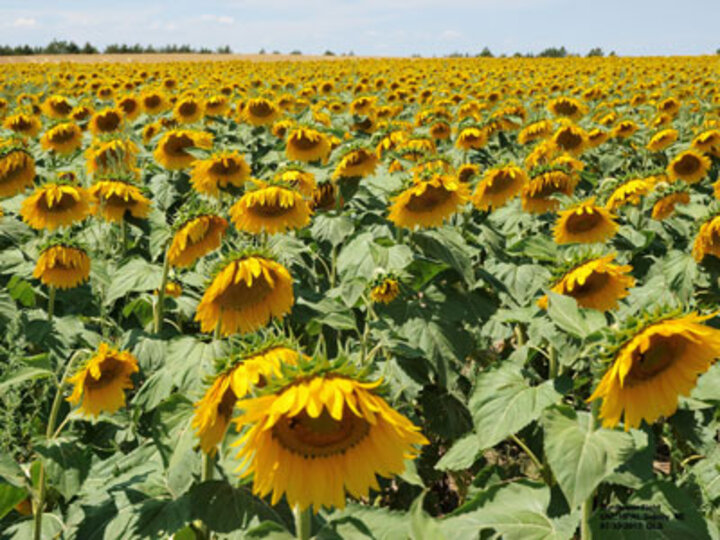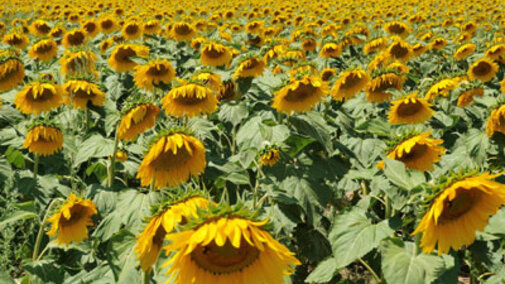Robert M. Harveson, Extension Plant Pathologist, Panhandle R&E Center; Sam Markell, North Dakota State University; Febina Mathew, South Dakota State University; Charlie Block, Iowa State University; Tom Gulya, USDA (retired); Sue Thompson, University of Southern Queensland, Australia (retired); and Malcom Ryley, University of Southern Queensland, Australia (retired)
Sunflower is an economically important field crop in the United States, with 2 to 2.5 million acres planted across the Great Plains, the majority in North and South Dakota with substantially high production also in Minnesota, Kansas, Colorado, and Nebraska.

Two types of sunflowers are grown: oilseed, which is consumed as oil, and confectionary, which is grown for direct human consumption. Both types provide an important source of income. While sunflowers produced for oil are competitively priced with other oilseed crops, confectionary types bring a more lucrative premium price.
Sunflowers can be impacted by dozens of diseases. Based on annual surveys conducted by the National Sunflower Association, diseases are routinely one of the three biggest yield-limiting factors.
Despite the economic importance of sunflower and the substantial impact that diseases have on its production, there have been very few sunflower pathology resources available to assist sunflower growers, sunflower seed companies and agricultural professionals. This is true for both Extension, and academic reference material. Thus identifying a disease correctly is likely a significant challenge for anyone in the industry.
Accurate identification is the first step toward the successful use of IPM (integrated pest management) or any management technique.
Creation of the SPWG
In 2013, the Sunflower Pathology Working Group (SPWG) was established with the mission of helping educate and ultimately manage sunflower diseases by increasing knowledge and awareness of diseases through the production and distribution of both extension and academic research-related literature pertaining to diseases in the sunflower crop. This effort has been funded through the North Central IPM Center Working Group Program, which in turn is provided through grants by the U.S. National Institute of Food and Agriculture.
Our group initially began with four pathologists (including myself) from California, North Dakota, Nebraska, and Iowa. It has expanded to include another pathologist from South Dakota and internationally, two from Australia, which also produces sunflowers.
Our initial objectives were:
- to identify what information growers needed most and in what media format;
- develop and disseminate that information;
- develop academic reference information that would help others develop management strategies; and
- increase communication among pathologists working on sunflower and work together to synergize our efforts.
Outcomes to Date
In the span of five years, major outputs by this small group include the first Compendium of Sunflower Diseases and Pests, published by the American Phytopathological Society (APS) Press (an entire book); two book chapters; multiple grant proposals; and research and extension publications.
Extension-oriented literature consists of materials ranging from disease playing cards to diagnostic cards and guides. The initial set of 20 disease diagnostic cards sold out, and has been reprinted, as well as translated into Chinese and re-released in that country.
In 2018 we published two more refereed journal articles. An invited review article focusing on the results of the 15-year sunflower surveys by the National Sunflower Association has recently been accepted and will be published early next year in the applied plant pathology journal Plant Disease as a feature article.
Plans for next year include additional articles for the APS journals Plant Health Progress and Plant Health Instructor, and an interactive iBook, all focusing on diagnostics and education.
Significance of this Group
Prior to the establishment of the Sunflower Working Group in 2013, the most up-to-date monograph on sunflower diseases was published in 1997. Additionally, a disease compendium focusing on sunflowers did not exist. The compendium series from APS Press is the most important and widely read pathology crop reference guide worldwide.
Lastly, very few pathology or IPM Extension publications on sunflower diseases were available. SPWG has now fully begun the process of rectifying these limitations. The initial five-year USDA grant funding this work has expired, but we have recently re-submitted a new proposal to continue our mission of creating and distributing disease literature for this crop for another five years and beyond.

